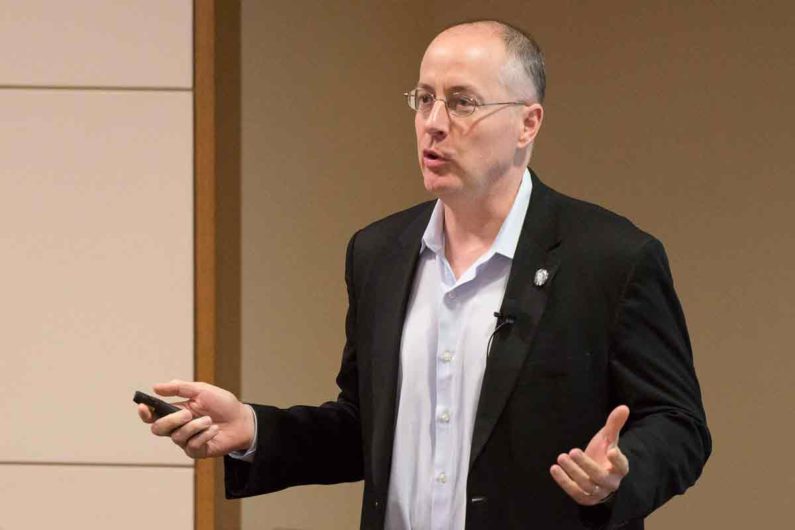Stanford researchers say U.S. policies on drugs and addiction could use a dose of neuroscience
Legal and illegal drugs are killing more people than AIDS ever did, yet the nation’s drug policies are based on unproven assumptions about addiction. Neuroscience could help shape more effective policies and save lives.
Tens of thousands of Americans die from drug overdoses every year – around 50,000 in 2015 – and the number has been steadily climbing for at least the last decade and a half, according to the National Institute on Drug Abuse. Yet a team of Stanford neuroscientists and legal scholars argues that the nation’s drug policies are at times exactly the opposite from what science-based policies would look like.

Professor Keith Humphreys is one of the leaders of the Stanford Neuroscience Institute’s Neurochoice Big Idea initiative. (Image credit: L.A. Cicero)
“Drug policy has never been based on our scientific understanding,” said Robert Malenka, a professor of psychiatry and behavioral sciences and a coauthor on the paper. Instead, it is based mostly on culture and economic necessities – and a misguided desire to punish drug users harshly.
The time has come, he and coauthors write June 22 in the journal Science, to do better.
“We have an opioid epidemic that looks like it’s going to be deadlier than AIDS, but the criminal justice system handles drug addiction in almost exactly opposite of what neuroscience and other behavioral sciences would suggest,” said Keith Humphreys, a professor of psychiatry and behavioral sciences and one of the leaders of the Stanford Neurosciences Institute’s Neurochoice Big Idea initiative.
(Not) thinking about the future
A central problem, the authors argue, is that drug use warps the brain’s decision-making mechanisms, so that what matters most to a person dealing with addiction is the here and now, not the possibility of a trip up the river a few months or years from today.
“We have relied heavily on the length of a prison term as our primary lever for trying to influence drug use and drug-related crime,” said Robert MacCoun, a professor of law. “But such sanction enhancements are psychologically remote and premised on an unrealistic model of rational planning with a long time horizon, which just isn’t consistent with how drug users behave.”
What might work better, Humphreys said, is smaller, more immediate incentives and punishments – perhaps a meal voucher in exchange for passing a drug test, along with daily monitoring.
The environment in which individuals live matters, too, Humphreys said – especially when that environment pushes alcohol, cigarettes and prescription painkillers hard. Cigarette advertising, for example, works to make smoking seem like a pleasant escape from the grind of daily life. Meanwhile, drug companies’ advertising campaigns helped push American doctors to prescribe painkillers at much higher rates than in other countries, a fact that has likely contributed to the country’s growing epidemic of opioid addiction.
Pragmatism, not apologetics
The scientists argue that basing policy on science rather than on a desire to punish addicts would improve lives, including victims of drug-related crime.
“To learn that addictive drugs distort the choice process is not the same as showing that addicts are incapable of making choices. Addicts already know full well that their behavior is inappropriate and stigmatized,” MacCoun said. “But mostly I think questions of morality distract from very practical questions about what works and what doesn’t work to reduce drug-related harm.”
And, the researchers say, the costs of current policy are staggering: on average 91 Americans die every day from opioid overdoses.
Basic science for the public good
The new commentary is timed to appear four days before a much-anticipated report from a presidential commission on drug addiction. While it may not have an impact on that particular report, Humphreys and his coauthors say they hope the commentary and the Neurochoice Initiative it is part of will make a difference in a critical area of public policy.
To that end, Neurochoice brings together neuroscientists, psychologists, public policy scholars and others to tackle drug addiction and find better treatments and policies for dealing with the problem. It has already produced some intriguing results. Professor of Psychology Brian Knutson and colleagues, for example, recently showed that brain scans could help predict which adolescents would initiate excessive drug use in the future. Those are the kinds of results, the authors write, that might guide better laws and practices in the future.
Each of the authors is a member of the Stanford Neurosciences Institute and its NeuroChoice project, which funded the research. Malenka is a member of Stanford Bio-X and the Nancy Friend Pritzker Professor of Psychiatry and Behavioral Science. Knutson is a member of Bio-X and an affiliate of the Stanford Woods Institute for the Environment. MacCoun is a senior fellow of the Freeman Spogli Institute for International Studies and the James and Patricia Kowal Professor of Law.
